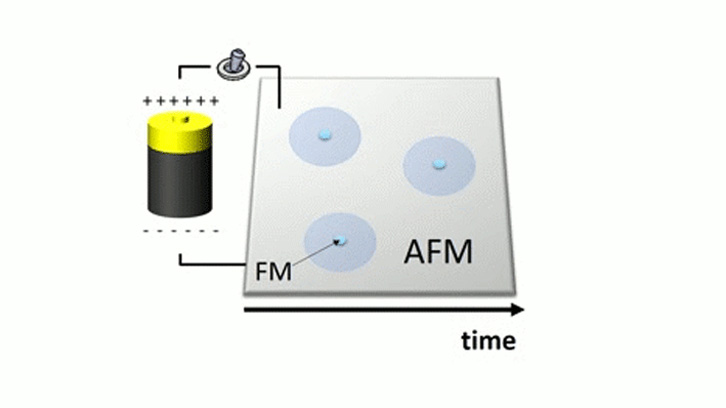Tunable time-dependent magnetoelectric response

We can find magnetic materials in a long list of devices we use on a daily basis. The one best known is the refrigerator magnet. But, of course, it is not the only example. Many magnets similar to refrigerator magnets are used to store information. In particular, the text you are reading right now is likely to be stored in memories based on magnetic materials. In these memories the magnets point their north pole up or down representing "0"s or "1"s, which is the basic memory element.
However, manipulating the north pole of such magnets is not easy. For this purpose, normally, magnetic fields are used. But the generation of these fields is very expensive from an energetic point of view. The reason for this is that the generation of magnetic fields is done through the circulation of an electric current flow. Generating this current already has a high energy cost. But, more importantly, the current circulation dissipates heat by Joule effect, which makes it necessary to incorporate cooling systems that require even more energy. Since memory elements are becoming smaller, the needed current density is progressively higher, hence there is a growing need to cool these devices. Therefore, finding new routes that do not require the use of magnetic fields for the writing of information onto magnetic materials is important to promote a new generation of computers capable of consuming less energy and, therefore, being more sustainable from the economic and environmental points of view.
One of the possible routes that would allow minimizing or avoiding the presence of magnetic fields would be the use of electric fields (i.e., voltages) for writing. However, this is only possible in the presence of magnetoelectric coupling, which is not always easy to obtain. The use of electric fields would allow building up systems that would work in open circuit conditions. In open circuit, the transport current does not exist and therefore the energy consumption, the heat dissipation and the cooling requirements are minimized.
Sketch of the transition between antiferromagnetic (AFM) and ferromagnetic (FM) states depending on the applied electric voltage.
Using this premise (i.e., the use of electric fields to manipulate magnetization), it is interesting to study structures where magnetic and piezoelectric materials are combined. Piezoelectric materials are shrunk/expanded upon application of an electric field. If this movement is transmitted to an adjacent magnetic material, magnetoelectric coupling takes place, thus resulting in the possibility of modulating the magnetization by electric field. A recent collaborative study between the UAB, ICMAB, ICN2 and ALBA, carried out in the framework of the SPINPORICS and #ESRAM projects, and published in the journal ACS Applied Materials & Interfaces has revealed that, under certain conditions, it is possible to manipulate very effectively the magnetization in a magnetic/piezoelectric structure. Importantly, the study unexpectedly revealed that magnetization can be manipulated by electric field in a way that its response can be made time-dependent. This could be very interesting for security elements, where it may be desirable for the information to be visible only for a short period of time to avoid the possibility of making copies.
Laboratory of Multifunctional Oxides and Complex Structures
Instituto de Ciencia de Materiales de Barcelona (ICMAB-CSIC)
ignasifinamartinez@gmail.com
Jordi Sort Viñas
Professor ICREA
Gnm3 Group
Physics Department
Universitat Autònoma de Barcelona
Jordi.sort@uab.cat
References
Fina, Ignasi; Quintana, Alberto; Padilla-Pantoja, Jessica; Martí, Xavier; Macià, Ferran; Sánchez, Florencio; Foerster, Michael; Aballe, Lucia; Fontcuberta, Josep; Sort, Jordi. Electric-Field-Adjustable Time-Dependent Magnetoelectric Response in Martensitic FeRh Alloy. ACS Appl Mater Interfaces. 2017 May 10; 9(18):15577-15582. DOI:10.1021/acsami.7b00476. Epub 2017 May 1.
http://pubs.acs.org/doi/abs/10.1021/acsami.7b00476


